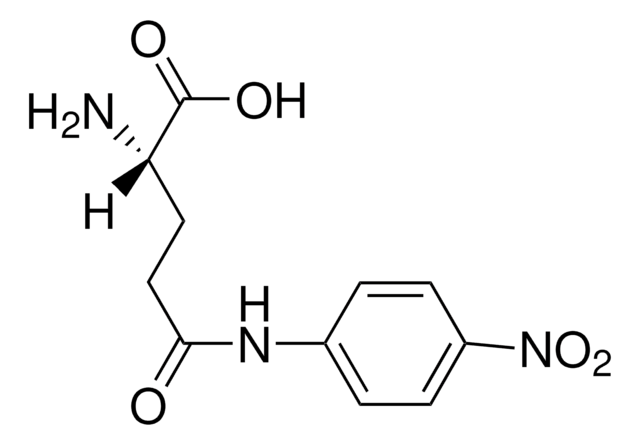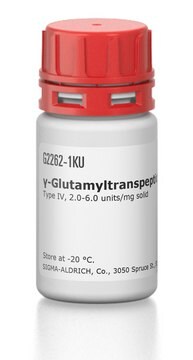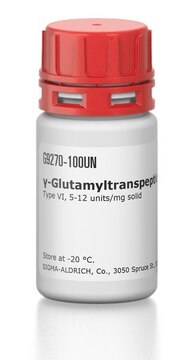G6133
L-Glutamic acid γ-(p-nitroanilide) hydrochloride
γ-glutamyl transpeptidase substrate
Synonym(s):
L-γ-Glutamyl-p-nitroanilide
About This Item
Recommended Products
Assay
≥98% (HPLC)
form
powder
solubility
water: 5 mg/mL, clear, yellow
storage temp.
2-8°C
SMILES string
Cl.NC(CCC(=O)Nc1ccc(cc1)N(=O)=O)C(O)=O
InChI
1S/C11H13N3O5.ClH/c12-9(11(16)17)5-6-10(15)13-7-1-3-8(4-2-7)14(18)19;/h1-4,9H,5-6,12H2,(H,13,15)(H,16,17);1H
InChI key
OJEVFSFTVARWQX-UHFFFAOYSA-N
Application
- or an inhibitor of the cell membrane glutamine transporter to study the effects of blocking glutamine uptake on esophageal adenocarcinoma (EACC) and thioredoxin-interacting protein (TXNIP)
- in glutamine ELISA assay to treat confluent differentiated uninfected human colonoid monolayer (HCM) in apical and basolateral compartments to study its effects
- to study its effect on SLC1A5_var-mediated mitochondrial glutamine transport inhibition
- to study its effects on cellular glutathione levels, cellular reactive oxygen species (ROS) levels, and mitochondrial ROS levels
Biochem/physiol Actions
Substrates
Storage Class Code
11 - Combustible Solids
WGK
WGK 3
Flash Point(F)
Not applicable
Flash Point(C)
Not applicable
Personal Protective Equipment
Certificates of Analysis (COA)
Search for Certificates of Analysis (COA) by entering the products Lot/Batch Number. Lot and Batch Numbers can be found on a product’s label following the words ‘Lot’ or ‘Batch’.
Already Own This Product?
Find documentation for the products that you have recently purchased in the Document Library.
Customers Also Viewed
Our team of scientists has experience in all areas of research including Life Science, Material Science, Chemical Synthesis, Chromatography, Analytical and many others.
Contact Technical Service







